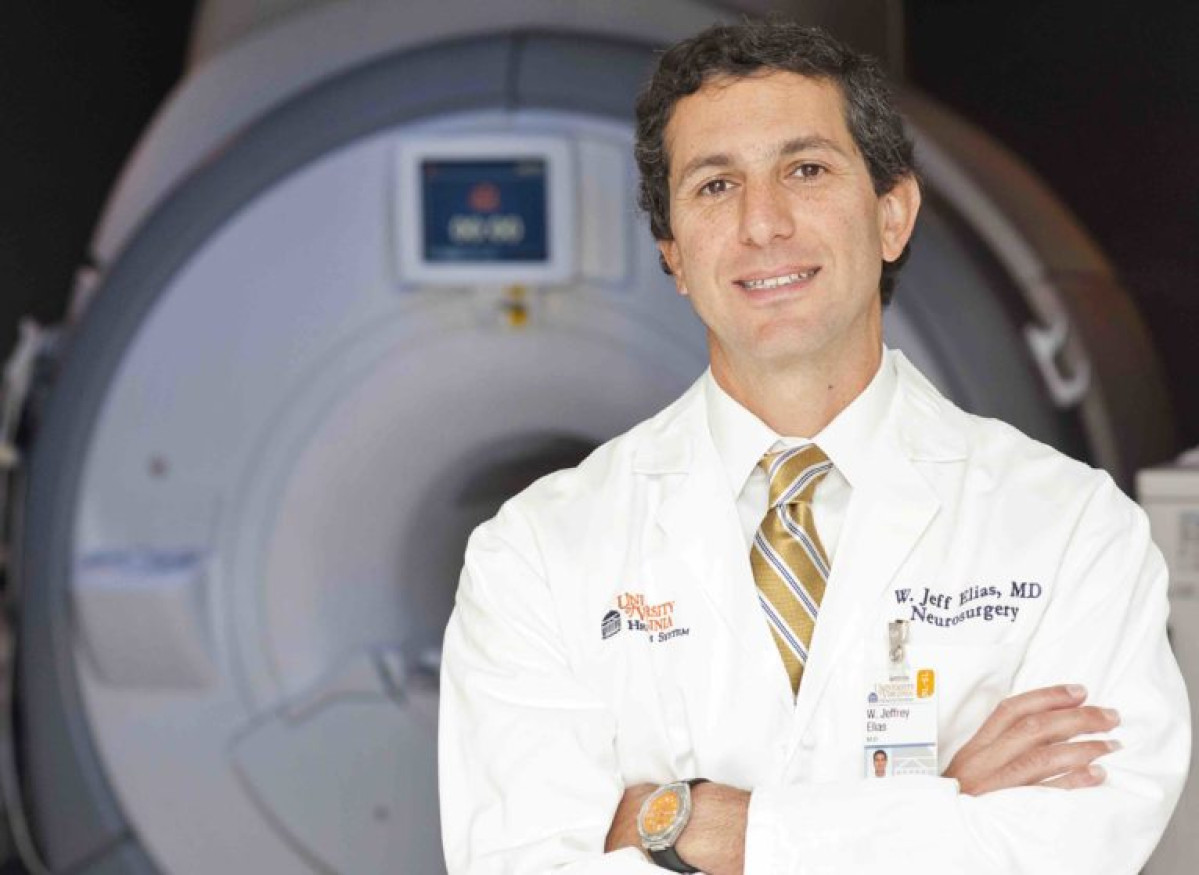Focused Ultrasound Trial Finds Promise for Parkinson’s Patients
March 10, 2023
The findings of a major international trial to test a high-tech, scalpel-free approach to treating movement problems caused by Parkinson’s disease have been published in the prestigious New England Journal of Medicine.
UVA neurosurgeon Jeff Elias, MD, and collaborators examined the benefits and risks of using focused ultrasound to target an area deep within the brain called the globus pallidus. The researchers wanted to see if the focused sound waves could improve trial participants’ ability to move and reduce the unwanted shaking and rigidity associated with Parkinson’s.
Of the 69 patients who received the procedure in the randomized trial, almost 70% responded to the treatment. Thirty-nine participants who received the procedure continued to see significant benefits three months later, and 30 of those assessed at the one-year mark continued to see benefits. The procedure, the researchers conclude, could be particularly useful for patients who are ineligible or unwilling to receive deep brain stimulation, a surgery that implants electrodes deep in the brain to accomplish the same symptom-management goals.
The focused-ultrasound trial results were shared with the federal Food and Drug Administration prior to publication and were an important consideration in the agency’s decision to expand approval of the technology for the treatment of Parkinson’s disease in 2021.
“This study is promising for patients with Parkinson’s disease and other neurological conditions. Ultrasound was precisely focused deep inside the brain to alter one of the abnormal circuits of Parkinson’s disease,” Elias said. “But it is important to understand that the treatment improved the neurological symptoms of PD and did not alter its course. Ultimately, we hope to someday cure PD.”
Focused Ultrasound for Parkinson's
The focused ultrasound procedure focuses sound waves inside the brain to disrupt faulty brain circuits, like how a magnifying glass can focus light. Unlike deep brain stimulation, the minimally invasive procedure does not require incisions or opening the skull. The procedure is guided by magnetic resonance imaging (MRI), so doctors can pinpoint the exact right spot in the brain before making any permanent changes.
Participants in the randomized Parkinson’s trial were assigned to receive either the focused-ultrasound treatment or a harmless pretend – or “sham” – procedure. In total, 69 received the actual treatment and 25 received the sham procedure. The participants’ symptoms were then assessed using two common rating scales, one for patients on medication and one for patients off medication.
Sixty-nine percent of the procedure recipients improved by at least three points on one or both of the rating scales. That’s compared with only 32% (seven participants) in the control group. In the control group, significant improvements were seen only in patients on medication.
Side effects reported by treatment recipients included trouble speaking, difficulty walking and loss of taste. The loss of taste and difficulty walking were mild and resolved on their own. One participant continued to experience slurred speech a year after the procedure, the researchers report.
Elias’ pioneering research into the use of focused ultrasound for Parkinson’s is just the latest in his more than decade-long effort to tap the vast potential of the technology. His prior work prompted the federal Food and Drug Administration to approve focused ultrasound for the treatment of essential tremor, a common movement disorder, in 2018. That approval represented a turning point for the technology and helped spur additional research at UVA and elsewhere.
Elias and his UVA Health colleagues continue to explore the many possible applications of focused ultrasound. For example, UVA Health last year joined with the Charlottesville-based Focused Ultrasound Foundation – a longtime supporter of UVA’s focused ultrasound research – to launch the world’s first center devoted specifically to combining focused ultrasound with immunotherapy to enhance the body’s ability to battle cancer. Other potential applications include using the technology to open the brain’s natural protective barrier to allow, for the first time, the targeted delivery of drugs for neurological diseases such as Alzheimer’s.
UVA’s transformative work with focused ultrasound was recently highlighted around the world by CNN’s Sanjay Gupta in a story that showcased a procedure conducted by Elias and his team.
About the Research
The Parkinson’s research team consisted of Vibhor Krishna, Paul S. Fishman, Howard M. Eisenberg, Michael Kaplitt, Gordon Baltuch, Jin Woo Chang, Wei‑Chieh Chang, Raul Martinez Fernandez, Marta del Alamo, Casey H. Halpern, Pejman Ghanouni, Roberto Eleopra, Rees Cosgrove, Jorge Guridi, Ryder Gwinn, Pravin Khemani, Andres M. Lozano, Nathan McDannold, Alfonso Fasano, Marius Constantinescu, Ilana Schlesinger, Arif Dalvi and Elias. Elias is a consultant for Insightec, the manufacturer of the focused ultrasound technology; a full list of the authors’ disclosures is included in the paper.
Financial support for the Parkinson’s trial was provided by Insightec.
To keep up with the latest medical research news from UVA, subscribe to the Making of Medicine blog at http://makingofmedicine.virginia.edu.
